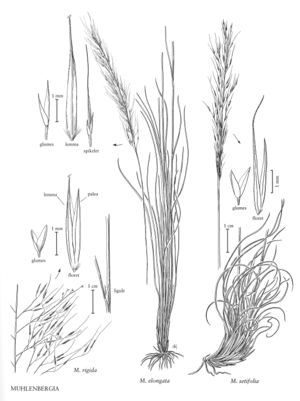Muhlenbergia rigida
Plants perennial; cespitose, not rhizomatous. Culms 40-100 cm, erect, not conspicuously branched; internodes mostly smooth, sometimes scabridulous below the nodes. Sheaths longer than the internodes, smooth or scabridulous, basal sheaths rounded, not becoming spirally coiled when old; ligules (1)3-12(15) mm, firmer basally than distally, obtuse to acute, often lacerate; blades 12-35 cm long, 1-3 mm wide, flat or involute, smooth or scabridulous abaxially, scabridulous or hirtellous adaxially. Panicles 10-35 cm long, 2-5(12) cm wide, loosely contracted to open, purplish; primary branches 0.4-10 cm, lax, capillary, usually appressed to ascending, occasionally diverging up to 80° from the rachises, naked basally; pedicels 1-10 mm. Spikelets 3.5-5 mm, purplish. Glumes equal, 1-1.7(2) mm, exceeded by the florets, usually glabrous, sometimes mostly hirtellous but glabrous distally, 1-veined, obtuse to subacute, unawned; lemmas 3.5-5 mm, narrowly lanceolate, purplish, calluses hairy, hairs to 0.5 mm, lemma bodies scabridulous to scabrous, apices acuminate, awned, awns 10-22 mm, clearly demarcated from the lemma bodies, flexuous; paleas 3.5-5 mm, narrowly lanceolate, scabridulous, acuminate; anthers 1.7-2.3 mm, purplish. Caryopses 2-3.5 mm, fusiform, brownish. 2n = 40, 44.
Distribution
Ariz., N.Mex., Tex.
Discussion
Muhlenbergia rigida grows on rocky slopes, ravines, and sandy, gravelly slopes derived from granitic and calcareous substrates, at elevations of 1200-2200 m. It is often a common upland bunchgrass, and is also grown as an ornamental plant.
Muhlenbergia rigida grows in two disjunct areas: the southwestern United States south to Chiapas, Mexico, and in Ecuador, Peru, Bolivia, and Argentina. It differs from M. setifolia and M. reverchonii in its purplish, scabridulous to scabrous lemmas.
Selected References
None.
